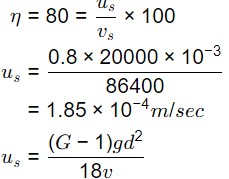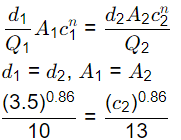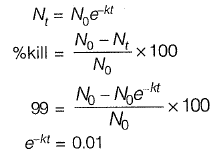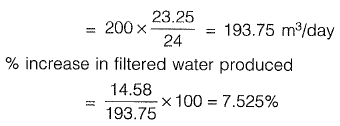Past Year Questions: Water Treatment - 1 | Environmental Engineering - Civil Engineering (CE) PDF Download
Q1: A hypothetical multimedia filter, consisting of anthracite particles (specific gravity: 1.50), silica sand (specific gravity: 2.60), and ilmenite sand (specific gravity: 4.20), is to be designed for treating water/wastewater. After backwashing, the particles should settle forming three layers: coarse anthracite particles at the top of the bed, silica sand in the middle, and small ilmenite sand particles at the bottom of the bed.
Assume
(i) Slow discrete settling (Stoke's law is applicable)
(ii) All particles are spherical
(iii) Diameter of silica sand particles is 0.20 mm
The correct option fulfilling the diameter requirements for this filter media is (2024 SET-2)
(a) diameter of anthracite particles is slightly less than 0.35 mm and diameter of ilmenite particles is slightly greater than 0.141 mm.
(b) diameter of anthracite particles is slightly greater than 0.35 mm and diameter of ilmenite particles is slightly less than 0.141 mm.
(c) diameter of anthracite particles is slightly less than 0.64 mm and diameter of ilmenite particles is slightly less than 0.10 mm.
(d) diameter of anthracite particles is slightly greater than 0.64 mm and diameter of ilmenite particles is slightly less than 0.10 mm.
Ans: (a)
Sol:  Let the settling velocity of anthracite pacticle at top, silica pacticle at middle \& ilmenite pacticle at bottom, after back washing be (VS)T,(VS),(VS)B respectively.
Let the settling velocity of anthracite pacticle at top, silica pacticle at middle \& ilmenite pacticle at bottom, after back washing be (VS)T,(VS),(VS)B respectively.
For Middle silica sand vs = K(2.6 - 1)(0.2)2
vs = K(2.6 - 1)(0.2)2
VS = K(1.6)(0.2)2 where, K = γω/18μ
For Top Anthracite
(VS)T = K(GS2 − 1)(D2)2
( VS)T = K(0.5)(D2)2
As anthracite lies above silica layer
So, anthracite particles should have settling velocity less than silica particles
(VS)T < VS
So, K(0.5)(D2)2 < K(1.6)(0.2)2 D2 or DTop <0.357 mm
D2 or DTop <0.357 mm
For bottom ilmenite sand As, ilimite layer lies below silica lyers
As, ilimite layer lies below silica lyers
So, ilimite particles should have settling velocity greater than silica
i.e., (VS)B > VS D3 or Dbottom > 0.141 mm
D3 or Dbottom > 0.141 mm
Hence, diameter of anthracite particle is slightly greater than 0.35 mm & diameter of ilmenite particle is slightly greater than 0.141 mm.
Q2: A water treatment plant treats 25 MLD water with a natural alkalinity of 4.0mg/l (as CaCO3). It is estimated that during coagulation of this water, 450 kg day of calcium bicarbonates (Ca(HCO3)2) is required based on alum dosage.
Consider the atomic weight as: Ca−40, H−1, C−12, O−16 .
The quantity of pure quick lime CaO (in kg) required for this process per day is ______ (round off to 2 decimal places) (2024 SET-1)
Ans: 99 to 100
Sol: Natural alkalinity = 4mg/l as CaCO3
Alkalinity req 
 ⇒ Alkalinity needed to be provided through outside source = (11.11 − 4) = 7.11mg/l as CaCO3 =7.11/50 milieq /l
⇒ Alkalinity needed to be provided through outside source = (11.11 − 4) = 7.11mg/l as CaCO3 =7.11/50 milieq /l
⇒ CaO required = 7.11/50 milieq /l
Q1: Which of the following is/are NOT active disinfectant(s) in water treatment? (2023 SET-2 )
(a) ⋅OH (hydroxyl radical)
(b) O3 (ozone)
(c) OCl− (hypochlorite ion)
(d) Cl− (chloride ion)
Ans: (d)
Sol: O3, OH, OCl−are considered to be the active disinfectants in water treatment.
NOTE:
1. (OH−) Hydroxyl ion is not an active disinfectant.
2. (Cl−) chloride ion reduces disinfection efficiency of free chlorine (OCl− and HOCl).
Q2: A flocculator tank has a volume of 2800 m3. The temperature of water in the tank is 15ºC, and the average velocity gradient maintained in the tank is 100/s. The temperature of water is reduced to 5ºC, but all other operating conditions including the power input are maintained as the same. The decrease in the average velocity gradient (in %) due to the reduction in water temperature is ____ (round off to nearest integer).
[Consider dynamic viscosity of water at 15ºC and 5ºC as 1.139 × 10−3 N−s/m2 and 1.518 × 10−3 N−s/m2, respectively] (2023 SET-1)
Ans: 12 to 15
Sol: Given,
Volume of flocculation tank (V) = 2800 m3
At T = 15ºC
G15ºC = 100/s,
η15ºC = 1.139 × 10−3 N−s/m2
At T = 5ºC
G5ºC = ?
μ5ºC = 1.518 × 10−3 N−s/m2
∵ Temporal mean velocity gradient,
P and V are constant.
So, G2μ = constant
1002 × 1.139 × 10−3 = G25ºC × 1.518 × 10−3
G5ºC = 86.62 sec−1
The decrease in velocity gradient
= 13.38%
Q3: In the following table, identify the correct set of associations between the entries in Column-1 and Column-2. (2023 SET-1) (a) P-II, Q-I, S-III
(a) P-II, Q-I, S-III
(b) Q-III, R-II, S-IV
(c) P-IV, R-I, S-II
(d) P-III, Q-I, R-IV
Ans: (d)
Sol: The correct associations are:
- P → III (Concentration Polarization)
- Q → I (Ponding)
- R → IV (Charge Neutralization)
Thus, the correct answer is (d): P-III, Q-I, R-IV.
Q1: A water treatment plant has a sedimentation basin of depth 3 m, width 5 m, and length 40 m. The water inflow rate is 500 m3/h. The removal fraction of particles having a settling velocity of 1.0 m/h is_______. (round off to one decimal place)
(Consider the particle density as 2650 kg/m3 and liquid density as 991 kg/m3) (2022 SET-1)
Ans: 0.38 to 0.42
Sol: 

Q2: Which of the following process(es) can be used for conversion of salt water into fresh water? (2022 SET-1)
(a) Microfiltration
(b) Electrodialysis
(c) Ultrafiltration
(d) Reverse osmosis
Ans: (b, d)
Sol: Desalination can be done by
Electrodialysis
Reverse osmosis
Q1: The hardness of a water sample is measured directly by titration with 0.01 M solution of ethylenediamine tetraacetic acid (EDTA) using eriochrome black T (EBT) as an indicator. The EBT reacts and forms complexes with divalent metallic cations present in the water. During titration, the EDTA replaces the EBT in the complex. When the replacement of EBT is complete at the end point of the titration, the colour of the solution changes from (2021 SET-2)
(a) blue-green to reddish brown
(b) blue to colourless
(c) reddish brown to pinkish yellow
(d) Wine red to blue
Ans: (d)
Sol: Hardness end point of titration → wine red to blu
Q1: Surface Overflow Rate (SOR) of a primary settling tank (discrete settling) is 20000 litre/m2 per day. Kinematic viscosity of water in the tank is 1.01 times 10−2cm2/s. Specific gravity of the settling particles is 2.64. Acceleration due to gravity is 9.81 m/s2. The minimum diameter (in ?m, round off to one decimal place) of the particles that will be removed with 80% efficiency in the tank, is _________. (2020 SET-1)
Ans: 14 to 15
Sol:

 d = 1.446 x 10-5 m
d = 1.446 x 10-5 m
= 14.46 μm
Q2: A water supply scheme transports 10 MLD (Million Litres per Day) water through a 450 mm diameter pipeline for a distance of 2.5 km. A chlorine dose of 3.50 mg/litre is applied at the starting point of the pipeline to attain a certain level of disinfection at the downward end. It is decided to increase the flow rate from 10 MLD to 13 MLD in the pipeline. Assume exponent for concentration, n = 0.86. With this increased flow, in order to attain the same level of disinfection, the chlorine does (in mg/litre) to be applied at the starting point should be (2020 SET-1)
(a) 3.95
(b) 4.4
(c) 4.75
(d) 5.55
Ans: (c)
Sol: Waterson law,
tch = Constant


= 4.747 mg/l.
Q3: During chlorination process, aqueous (aq) chlorine reacts rapidly with water to from CI−, HOCI, and H+ as shown below
CI2(aq) + H2O ⇌ HOCI + CI− + H+
The most active disinfectant in the chlorination process from amongst the following, is (2020 SET-1 )
(a) H+
(b) HOCI
(c) CI−
(d) H2O
Ans: (b)
Sol:

At pH < 5, chlorine does not react with water and remains as free chlorine.
(HOCl− + OCl− + cl2) are combinedly called freely available chlorine. Out of these forms of freely available chlorine, HOCl is most destructive. It is 80% more effective than OCl− ion. Hence, pH of water should be maintained slightly below 7.
Q1: Chlorine is used as the disinfectant in a municipal water treatment plant. It achieves 50 percent of disinfection efficiency measured in terms of killing the indicator microorganisms (E-Coli) in 3 minutes. The minimum time required to achieve 99 percent disinfection efficiency would be [2019 : 2 Marks, Set-II]
(a) 19.93 minutes
(b) 11.93 minutes
(c) 9.93 minutes
(d) 2 1.93 minutes
Ans: (a)
Sol: During disinfection variations of micro-organism is given by
Nt = N0e-kt
Nt = No. of micro-organism at time t
N0 = No. of micro-organism at time 0
So, disinfection efficiency at any time 't',


Q2: A water treatment plant treats 6000m3 of water per day. As a part of the treatment process, discrete particles are required to be settled in a clarifier. A column test indicates that an overflow rate of 1.5 m per hour would produce the desired removal of particles through settling in the clarifier having a depth of 3.0 m. The volume of the required clarifier, (in m3, round off to 1 decimal place) would be________. [2019 : 2 Marks, Set-II]
Ans: 500m3
Sol:

Q3: A wastewater is to be disinfected with 35 mg/L of chlorine to obtain 99% kill of micro-organisms. The number of micro-organisms remaining alive (Nt) at time f, is modelled by Nt = N0e-kt, where N0 is number of micro-organisms at t = 0, and k is the rate of kill. The wastewater flow rate is 36 m3/h and k = 0.23 min-1. If the depth and width of the chlorination tank are 1.5 m and 1.0 m respectively, the length of the tank (in m, round off to 2 decimal places) is_______ . [2019 : 2 Marks, Set-I]
Ans: 8.01m
Sol:



Q4: A 0.80 m deep bed of sand filter (length 4 m and width 3 m) is made of uniform particles (diameter = 0 40 mm, specific gravity = 2.65, shape factor = 0.85) with bed porosity of 0.4. The bed has to be backwashed at a flow rate of 3.60 m3/min. During backwashing, if the terminal settling velocity of sand particles is 0.05 m/s, the expanded bed depth (in m, round off to 2 decimal places) is_______ . [2019 : 2 Marks, Set-I]
Ans: 1.21m
Sol: Head loss of expanded bed = Head loss of unexpanded bed
Backwash velocity,
Q5: Sedimentation basin in a water treatment plant is designed for a flow rate of 0.2 m3/s. The basin is rectangular with a length of 32 m. width of 8 m and depth of 4 m. Assume that the settling velocity of these particles is governed by the Stokes' law. Given: density of the particles = 2.5 g/cm3, density of water = 1 g/cm3, dynamic viscosity of water = 0.01 g/(cm.s) gravitational acceleration = 980 cm/s2. If the incoming water contains particles of diameter 25 |am (spherical and uniform), the removal efficiency of these particles is [2019 : 2 Marks, Set-I]
(a) 100%
(b) 51%
(c) 78%
(d) 65%
Ans: (d)
Sol: Flow rate, Q0= 0.2 m3/sec
Plan area,
(PA) = LB = 32 x 8 = 256 m2
(OFR) over flow rate
Now, settling velocity of particle of size 25 μm be us


Q6: A completely mixed dilute suspension of sand particles having diameters 0.25, 0.35, 0.40. 0.45 and 0.50 mm are filled in a transparent glass column of diameter 10 cm and height 2.50 m. The suspension is allowed to settle without any disturbance. It is observed that all particles of diameter 0.35 mm settle to the bottom of the column in 30 s. For the same period of 30 s. The percentage removal (round off to integer value) of particles of diameters 0.45 and 0.50 mm from the suspension is_______ . [2019 : 1 Mark, Set-I]
Ans: 100%
Sol: Since sand particle of size 0.35 mm settles to the bottom of the column in 30 sec particles having size greater than 0.35 mm i.e. 0.45 and 0.50 mm will also settle in suspension at the bottom of column by 100% in 30 sec, infact these bigger sized particle will settle by 100% in less than 30 sec. So answer is 100%.
Q1: At a small water treatment plant which has 4 Filters, the rates of filtration and backwashing are 200 m3/d/m2 and 1000 m3/d/m2, respectively. Backwashing is done for 15 min per day. The maturation, which occurs initially as the filter is put back into service after cleaning, takes 30 min. It is proposed to recover the water being wasted during backwashing and maturation. The percentage increase in the filtered water produced (up to two decimal places) would b e _________ . [2018 : 2 Marks, Set-II]
Ans: 7.525%
Sol: Let total area of filters be 1 m2
Water used for backwashing
Water used for maturation
Total water wasted for backwashing and maturation
= 10.4166 + 4.166 = 14.58 m3
Water to be treated by filtered
Q2: A flocculation lank contains 1800 m3 of water, which is mixed using paddles at an average velocity gradient Gof 100/s. The water temperature and the corresponding dynamic viscosity are 30°C and 0.798 x 10-3 Ns/m2, respectively. The theoretical power required to achieve the stated value of G (in kW, up to two decimal places) is____. [2018 : 2 Marks, Set-II]
Ans: 14.36 kW
Sol: Power required P = μVG2
= 0.798 x 10-3 Ns/m2 x 1800 m3 x (1005)2
= 14364 Nm/s or Watt
= 14.364 kW
= 14.36 kW
Q3: A rapid sand filter comprising a number of filter beds is required to produce 99 MLD of potable water. Consider water loss during backwashing as 5%, rate of filtration as 6.0 m/h and length to width ratio of filter bed as 1.35. The width of each filter bed is to be kept equal to 5.2 m. One additional filter bed is to be provided to take care of break-down repair and maintenance. The total number of filter beds required will be [2018 : 2 Marks, Set-I]
(a) 19
(b) 20
(c) 21
(d) 22
Ans: (c)
Sol: Total water to be filtered = 99 x 1.05 MLD = 103.95 MLD
(Addition of 5% to be used for backwashing)
∴ Surface area of each filter = 36.504 m2
Total surface area required
Total no. of working units required
1 unit is to added as standby, thus total no. of units required = 21
Q1: A municipal corporation is required to treat 1000 m3/day of water. It is found that an overflow rate of 20 m/day will produce a satisfactory removal of the discrete suspended particles at a depth of 3 m. The diameter (in meters, rounded to the nearest integer) of a circular settling tank designed for the removal of these particles would be _____ . [2017 : 2 Marks, Set-II]
Ans: 8m
Sol:

Assuming diameter of tank to be 'd'
Q2: The spherical grit particles, having a radius of 0.01 mm and specific gravity of 3.0, need to be separated in a settling chamber. It is given that
- g = 9.81 m/s2
- the density of the liquid in the settling chamber = 1000 kg/m3
- the kinematic viscosity of the liquid in the settling chamber =10-6m2/s
Assuming laminar conditions, the settling velocity (in mm/s, up to one decimal place) is ________ . [2017 : 2 Marks, Set-I]
Ans: 0.436 mm/sec
Sol:

Q1: A water supply board is responsible for treating 1500 m3/day of water. A settling column analysis indicates that an overflow rate of 20 m/day will produce satisfactory removal for a depth of 3.1 m. It is decided to have two circular settling tanks in parallel. The required diameter (expressed in m) of the settling tanks is____ . [2016: 1 Mark, Set-II]
Ans: 6.91 m
Sol: Discharge to be treated by one tank,

|
14 videos|99 docs|98 tests
|
FAQs on Past Year Questions: Water Treatment - 1 - Environmental Engineering - Civil Engineering (CE)
| 1. What are the main processes involved in water treatment? |  |
| 2. Why is disinfection important in water treatment? |  |
| 3. What are the common methods of filtration used in water treatment? |  |
| 4. How does sedimentation work in the water treatment process? |  |
| 5. What are the environmental impacts of water treatment plants? |  |


























